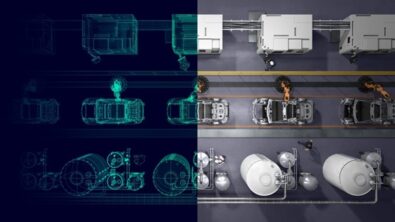How can SMBs use digitalization to compete against large organizations?

What does the future look like for startups and small-to-medium-sized businesses (SMBs)? It’s a future filled with increasing global competition, complexity and personalization. Products are expected to be smart, connected, integrated and sustainable. And these products can be anything from autonomous vehicles to smart watches.
Complex products include an increasing number of semiconductors and embedded systems, connect up to the cloud and everything in between. Amid this explosion of complexity, the solutions for companies to build their products must be cost-effective, flexible, open and capable of integration with other software.
Complexity is growing exponentially.
The reality is that most companies are trying to use yesterday’s processes to develop tomorrow’s products. Not only is digital transformation imperative but implementing the best solution to meet your company’s and your customers’ need is crucial to remain competitive. Meanwhile, the talent pool seems to be shrinking making it hard to recruit the workforce needed for innovation.
Large enterprises have the capital to invest in new technology, hardware and IT talent whenever they need it. Small and medium sized businesses often don’t have that luxury. They need a solution that is easy to use, open so that they can collaborate with their partners, OEMs and amongst their own department effectively, and ensure their software is integrated so data remains consistent.
Because change or modernization is needed to keep up with demand, this has been a challenge for many startups and SMBs.
Creating a digital transformation strategy

Moving into the digital future can seem overwhelming. The best digital transformation journey looks different for every company so it must be rooted in your strategy. This involves defining the biggest gaps and change of pace that works for your company, balancing impact and cost of change, and finding partners that help you achieve the greatest benefit.
There is no right first step to take on the journey. What matters is finding the solutions that fit your individual needs, your strategy, what your capabilities are today and your previous investments.
When it comes to financing and facilitating digital transformation, Software as a Service provides an easy way to scale up or down based on the needs of a project. With its on-demand and cloud functionalities and capabilities, it will be much easier for SMBs to take advantage of the most technologically advanced tools and services when they need it. This minimizes the cost of infrastructure and maintaining IT talent, allows for rapid deployment of software and ensures more opportunities to win bids on projects with more accurate estimates.
An open ecosystem
No organization exists in isolation. Small and medium sized businesses will need to collaborate with their partners, customers and more to increase efficiency, share data and parts securely and confirm products, software and information are interoperable.
Closed systems that don’t allow deep levels of interoperability create barriers, which can lead to ineffective products and missed opportunities, all while increasing time-to-market, frustrations amongst engineers working in different domains and costs.
The ability to collaborate in real-time is imperative. Whether it’s another department inside the organization or a partner on the other side of the world, engineering and manufacturing teams must have reliable information to work from that is accessible, preferably at any time, from anywhere and on any device.
Integrated engineering and manufacturing software
Just like people need to collaborate with one another, the software must be able to share information and data accurately. Therefore, the software one company uses should be standardized to ensure that it can communicate with its partner’s, customer’s or supplier’s software even if it’s different.
Siemens Xcelerator is our comprehensive, integrated portfolio of software, services and an application development platform. Integrating all the necessary manufacturing and engineering software allows for exact data and information to be exchanged. It’s through this standardized, integrated and open system that engineers, designers and factory operations managers can expect consistent accuracy as they design their products.
How small businesses compete against large enterprises
The explosion of complexity impacts all companies in every industry. How can small and medium sized companies compete against the awesome resources and investment capabilities of a large organization?

The answer is digitalization. By implementing the software and services that provide easy, open and integrated solutions, businesses can turn complexity into their competitive advantage. With cloud-based solutions and advanced SaaS technology, small and medium sized businesses can scale up or down as needed and invest in software without having to spend capital on IT infrastructure. A startup or small company’s workforce often wears multiple hats – this provides the ability to compete on a global scale even with fewer resources.
Siemens Xcelerator and Xcelerator as a Service are designed to help companies of all sizes create and leverage digital twins that provide new insights, opportunities and levels of automation to drive innovation. As a flexible solution, the possibilities are endless and the results will be accurate and reliable.
It’s one thing to insist that a company embrace a digital transformation journey, it’s another thing to implement a digital mindset strategy. We know that every industry and every company is different. Working with countless companies – from one-person startups to those at the top of the Fortune 500 list – Siemens has been able to guide this transformation by showing how a comprehensive digital twin approach can connect all tasks and processes of the entire lifecycles of product and production can solve the challenges.
Where can you learn more about digital transformation?
Learn more about Siemens Xcelerator and our partners
Watch our webinar: SaaS and the SMB for analytical insight into the benefits of software as a service and how it can help turn complexity into a competitive advantage.
Discover how these small businesses are using comprehensive digital twin technology to revolutionize their industries and compete on a global scale.
Surf Loch: How digitalization create the perfect wave
Becoming a supplier for large OEMs as an SMB | Siemens Software

